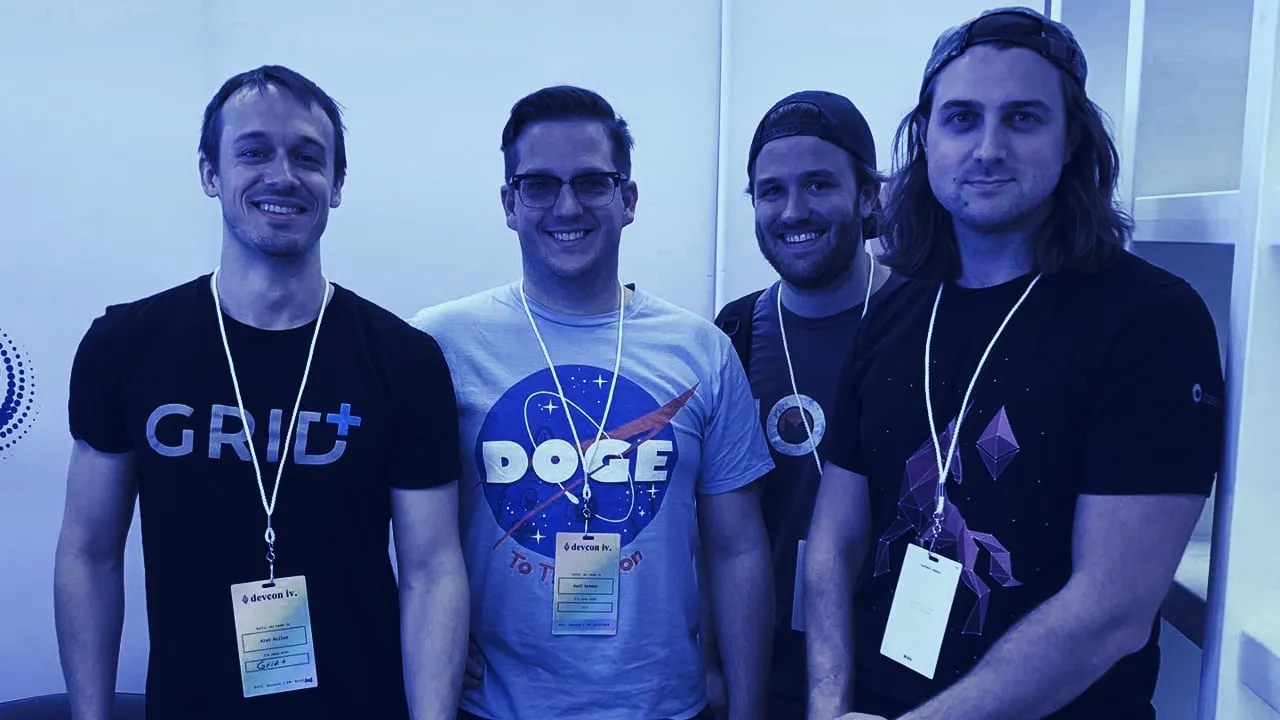It’s a brisk December morning on the streets of downtown Austin, Texas, and big things are happening on the 20th floor of One Hundred Congress Avenue.
Three young entrepreneurs are inching closer to realizing their dream of revolutionizing the energy market. If they succeed, they’ll eventually put themselves out of business—precisely as it should be for any business built on blockchain, they say.
Mark D’Agostino, Alex Miller, and Karl Kreder founded Grid+ in the spring of 2017 while working on proof-of-concept projects for large energy companies at ConsenSys—the Brooklyn, NY-based, blockchain incubator. (Obligatory disclosure: ConsenSys also funds Decrypt, which is editorially independent.) The energy company spun out of ConsenSys in October 2017 after a $29 million ICO, and has since embarked on a journey to change the way energy customers in Texas interact with the market.
But Grid+ is no longer just an energy company. In building the technology necessary to address the unique needs of its customers, a new world of possibility emerged—a path toward one of the most sought after goals in the cryptocurrency ecosystem: a way to transact in crypto, in the real world, without using a middleman, or converting to fiat. The company has made significant headway in the last year, and while it’s still a long ways away from lighting up the Lone Star state, circuits are already being switched on.
Building a REP
In June, Grid+ became a fully certified retail electric provider (REP) in the state of Texas—by far the largest deregulated energy market in the country. In Texas, consumers are largely accustomed to choosing their own REP, which is an intermediary between consumers and the utilities that actually generate and deliver power to customers’ homes.
REPs take on the capital and credit risks involved in buying electricity at wholesale and reselling it to retail energy customers at competitive fixed and variable rates. In this way, Grid+ Energy currently operates in much the same way as a traditional REP—with one crucial distinction: It doesn’t actually want to be a REP.
“We have to make a REP to comply with regulatory and market [requirements] in a deregulated energy market as they exist today,” says Kreder, the company’s chief security officer. “But the long-term goal is to build a system that eliminates the need for that intermediary using distributed cryptographic systems.” In other words, they will remove the middleman—which is themselves.
The first step in that grand scheme is to use cryptocurrency to make Grid+ as “light of an intermediary” as possible, he says. “And now you can start getting customers participating directly in the market.”
But it wasn't so easy. While crypto settles in real time, there was no mechanism in the market to allow for real-time, automatic payments in crypto—a key ingredient to providing the customer with the full array of benefits to real-time exposure in the energy market. Grid+ had to build it. And after seven months of work, they developed the company’s signature piece of hardware: a slick IoT device called the “Lattice1.”
Once fully implemented, the Lattice1 will allow energy customers to pay for their electricity within 15 minutes of consuming it. By taking less of a markup than most REPs, the company expects to reduce consumers' electricity bills by an initial 38 percent, on average—until, eventually, customers are paying for it at cost—roughly half of what REPs typically charge today. “And then it’s a public utility,” Kreder says. “So just like you have an electric grid, you’ll have a settlement infrastructure that everyone has access to and everybody can use at cost, not at profit.”
"Every crypto project—if it’s truly in the ethos and truly trying to add the value that we’re all saying is there—should eventually put itself out of business." Karl Kreder, cofounder and CSO
It's an audacious mission, and one that will no doubt attract its fair share of skeptics. We can count among them Dr. Carey King, a research scientist for the Energy Institute at The University of Texas at Austin. “If they're using a variable rate, then they're not at risk of buying electricity at too expensive of a cost for their customers, but they’re at risk at whatever the conversion rate is between bitcoins and dollars, or whatever currency they’re using," King says.
At the end of the day, REPs have to settle up with the Electric Reliability Council of Texas, the nonprofit responsible for managing Texas's electric grid. The council doesn't settle economic transactions in real time, he says. It takes them a while to sort it all out. "I mean, they've gotta manage the grid and just make it work," he says. "If they’re settling their bitcoin transaction in 15-minute intervals, they’re not going to know their monetary dollar transaction until a day or two later.”
But a little volatility in the crypto market isn't scaring away any true believers. Grid+ already mitigates some of that risk by converting the crypto they receive as payment to Dai, the Ethereum-based stablecoin. No, the real risk may come when the old guard gets hip to the disruption coming their way: paying for electricity in crypto, disintermediating the energy market and creating a “REP-less REP.” “If I were a commissioner, this would sort of raise my eyebrow a little bit in the wrong direction,” King says.
Indeed, regulators may ultimately be the bottleneck. Grid+ is fully aware of the bureaucratic challenges that await. But first things first: It's got to get its technology right.
“It’s working!”
The company’s chief technology officer, Alex Miller, walks us through a demo of the Lattice1 at Grid+ HQ in Austin. He starts by establishing a secure connection with the device, pairing his phone to the Lattice1 using the Grid+ MobilePay app. “No frills, really,” he says. “The app uses an SDK [Software Development Kit] in the code, which allows it to basically connect to the Lattice. Any app that wanted to build something that utilizes this Lattice could use that same SDK.”(The Grid+ app currently only supports bitcoin, ether, or ERC-20s, but Miller says the company would love to see others jump in and build “more interesting” applications that move other currencies.)
From a layman’s perspective, the process looks as simple as pairing your smartphone to an Amazon Echo or a set of bluetooth speakers—enter your PIN and away you go—yet there is clearly something much more sophisticated taking place. The Lattice1 is essentially a hardware wallet, though it features several added layers of security and functionality of which Kreder and Miller proudly boast. Miller pulls out another Grid+ invention—the Grid+ Safe Card—and inserts it into the Lattice’s built-in card reader.
“The chip [on the Safe Card] is basically the same as you’d find in a debit card,” he says. “And that’s where the [private] keys are stored. There’s another one of these chips inside of [the Lattice],” which is the “default wallet” of the device, he explains. Kreder says he likes to think of the Lattice1 as a “personal checking account” and the Safe Cards as either “savings accounts” or “cash,” depending on how you want to use them. The cards can be used to backup the primary account that’s stored on your Lattice at home, or they can store secondary accounts that you carry with you and spend as you go.
Within moments, Miller sends $10 worth of ETH from the account on the card to the account on the Lattice, confirming the transaction by entering his PIN on the device. A true-blue, peer-to-peer, crypto transaction made easy—without a middleman in sight. Then things get really interesting.
“If I didn’t want to be next to my wallet to spend currency, what I can do is set up a permission,” he says. From his phone, Miller tells his Lattice that he’d like to allow it to spend up to 1 ETH per week. The Lattice asks for permission, and Miller grants it by entering his PIN once again. He turns to the mobile app again and sends $2 worth of ETH to an ether address. “And it’s going to—it should auto-sign. And it worked—yay!” His surprise is as authentic as his enthusiasm.
After all, the Lattice1—the complex bit of technology that it is—is not yet ready for mass production, and the team is still working out the kinks. “When you’re doing so many things: hardware, firmware, software, crypto, energy—it’s a very long technology stack,” says Kreder. “One day, we’re like, ‘It’s working!’ And then the next day, we’re like, ‘Oh, it’s broken.”
“Oh, it’s working again!”
“So, it’s a very…” Kreder pauses for a moment. “It’s fun right now.”

Yet the progress Grid+ has made thus far shouldn’t be understated. Despite setbacks, the company plans to roll-out the Lattice1 to its first batch of customers—the “alphas”—by the beginning of Q2 2019. The alpha group is still a small sample—about a dozen “friends and family,” says Kreder. A larger beta group comes in mid-January, which the company expects to number around 300 or so crypto-curious souls.
“We’re incrementally rolling out,” the CSO explains. “We have our alpha and then our beta, and then as we have technology that we’re pushing out, [it’ll go] to the alpha group first. If that tests out, then we’ll push that out to the beta group.”
The alpha group is able to pay their electricity bills to Grid+ in crypto right now, but they must do so manually and at a standard 30-day interval. This group can also begin using the Grid+ token as a “coupon” toward a discount on 500 kilowatt hours of electricity, eliminating the 20 percent markup Grid+ currently charges. Once they get their hands on their Lattices, they can start setting up automatic payments, loading up their devices with what amount to “credits”—if customers prefer to think of them that way.
“From a consumer standpoint, if they wanted to sign up and didn't want to know anything about crypto, we wouldn't even have to utter the word,” Kreder says. The idea is for people to be “able to handle crypto in a secure way that they are not necessarily deeply aware of.” The Lattice1, the Safe Cards, they’re designed to make it all “look and feel understandable without having to dive into the minutia of cryptocurrency.”
“If I hand my mother a Lattice1, and she reads the directions and plugs it in, she can use it,” he says. “I don’t have to get into the details of it. I don’t have to scare her.”
By summer, Kreder says the company hopes to allow customers to begin incrementally shrinking their payment intervals as it adds functionality to the Lattice1. “I’d say maybe by Q3 our alpha will be able to do 15-minute type things with dispatchable loads”— industry jargon for energy sources that are used on demand according to individual needs. In other words, once Lattices are up and running, Grid+ Energy customers will be able to fully customize their usage by syncing the Lattice1 with smart thermostats and, in time, the state-mandated smart meters that are already installed in nearly every Texas residence.
“The idea with the device right now for people is sort of like a manager,” says Miller. “It takes care of your payments, and it takes care of several levers [to which you have access] to reduce your bill by turning off your electricity for a period of time when the price spikes.” The advantage of Grid+, he explains, is that it has access to that price information. “We know when it’s a really hot day, and it’s a lot hotter than expected and prices are shooting up. We have the ability to essentially act as that price oracle for all our units.”
“That’s something Nest can’t do on their own,” Miller says proudly. “They’re not an energy company.”
Indeed, and neither is Grid+, at least not strictly speaking.
The Morpheus Moment
Pivot is probably the wrong word to use. Kreder says Grid+ remains focused on the energy market, and the company is confident that this is where it will prove its technology’s first use case. But the excitement with which the team speaks of the grander vision cannot be denied. Grid+ is aiming higher—dreaming bigger. And things are falling into place.
“With these tools that I just demoed, you actually could have a working point-of-sale terminal. Like, from day one,” says Miller. Imagine a food truck, he says. “The merchant puts [the Lattice1] out on the ledge. They wait for customers to come in and insert their cards. Then, [the merchant] basically makes a request to send ether to himself.”
But not just ether either. The Lattice1 is designed to be “blockchain agnostic,” says Kreder. “It could be usable on Bitcoin, Ethereum, Litecoin, whatever. It’s just a generalized blockchain interface, and as long as your merchants are willing to accept the asset, it would just go directly to the merchant.”
Kreder says the goal is to obtain Payment Card Industry certification for the Lattice1—allowing it to accept VISA and MasterCard payments as well. Additionally, Grid+ is currently working with other companies to attempt to standardize the card interface used on the Lattice1 so that’s interoperable with multiple blockchain cards from multiple companies—all using a common standard. The result would be a single payment terminal to rule them all, accepting VISA, MasterCard, or Blockchain—any blockchain.
It’s unlike anything currently available on the market—even other blockchain-based, point-of-sale devices and crypto debit cards. “It’s different because it’s not going through any system—and it wouldn’t be going through fiat,” says Kreder. “You would actually plug it into the terminal, and you would pay in crypto from your card directly to the merchant.”
The implications are vast, and they’re certainly not lost on the ambitious trio of blockchain entrepreneurs: “It sort of, like, that ‘Morpheus moment,’” Kreder says. “Oh, what are you telling me, you can dodge bullets?”
(“No, Neo,” Morpheus responds in “The Matrix.” “I’m telling you, that when you’re ready, you won’t have to.”)
“Well, one day, if you really believe in crypto,” Kreder says, “you won’t have to convert it back to dollars.”
“Crypto in itself will be the mechanism by which you can do commerce,” he says. That’s the dream, anyway. “The fiats go away, and you’re not having to convert them in and out. You have this free and fair and apolitical monetary system that we can use to our societal benefit.”
The belief in crypto as a democratizing force for good is the same driving force behind the company’s desire to eventually remove itself from the equation. “Every crypto project—if it’s truly in the ethos and truly trying to add the value that we’re all saying is there—should eventually put itself out of business,” Kreder says. He insists that every business built on blockchain must understand this: Your enterprise “should run to zero profit by definition.”
But if you don’t, Grid+ is happy to help nudge you along your way. “What we’re doing is looking at the traditional businesses that sit there for years and decades and centuries, and they just continue to operate as intermediaries and continue to take these percentages and try to consolidate monopolies and leverage that. What we’re trying to do is make it so that those don’t exist.”
It’s going to take a long time to get there, Kreder admits. As accessible as the company is trying to make crypto, regulatory structures still stand in its way. But the dream lives on. And for now, Grid+ will continue to do what it can to keep the lights on.
Tim Copeland contributed additional reporting to this story.

